13 Yoga Sequences for Tight Hips and Hamstrings
8 minute read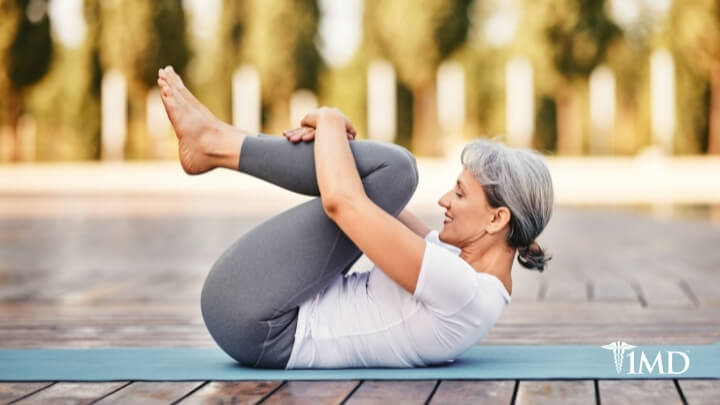
You are not alone if you suffer from tight hips and hamstrings; many people suffer the associated aches and strains daily. One theory is that the daily stresses of life cause us to hold a great deal of negative energy in our hips and hamstrings.
Opening these areas up are a great way to release this negativity. Certain yoga poses help to loosen and stretch the tight muscles. Once the muscles are relaxed and the negative energy is released, you will feel better as your body, mind and spirit become uplifted.
Why You Need Yoga
Yoga that helps to loosen hip and hamstring muscles also decreases the risk of injury, especially in athletes. Once these areas are opened, there is decreased strain on other areas of the body like your knees and back.
Lower back pain is often caused by hamstring tightness so stretching these areas can gradually decrease back aches and pain. Additionally, yoga poses help to improve your posture. Seated desk jobs can decrease the quality of posture.Yoga enhances flexibility and stretches postural muscles, allowing you to sit and stand taller.
Yoga Sequence for Hips and Hamstrings
Whether you are new to yoga or a pro, the following poses are perfect for opening up your hips and hamstrings. Ideally, you want to hold each pose for about one minute, breathing deeply as you hold the post.
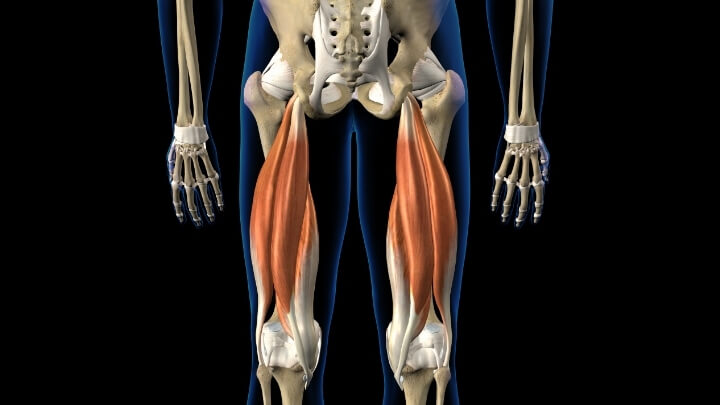
| Related: Lower Back Exercises & Stretches for a Strong, Pain-Free Back |
If you are not able to breathe during any of the poses, then you may need to adjust and pull back slightly. Breathing should be natural and easy, not labored, and the point of the poses is to relax you, not strain you even more.
Remember that for any of the poses that are one-sided, you will need to repeat the pose for your other side.Patience is the key when it comes to yoga, and with time you will notice the difference, beginning to feel more flexible.
Crescent Lunge
For this pose, reach your arms straight up with your shoulders relaxed. Step your back leg out behind you and bend the front leg so your knee is over your ankle. Make sure your knee does not go forward over the ankle and if you need help balancing, move your back leg out towards the side. Keep your hips and pelvis level and squared off to the front of the mat.
Position your body in a lunge with your front knee stacked over your front foot, your back leg to the side. The middle of your back foot should be in line with the heel of your front and your pelvis needs to be leveled, facing the side of the mat. Your arms should be outstretched and shoulders relaxed.
| Related: Powerful Qigong Exercises to Strengthen Arthritic Knees |
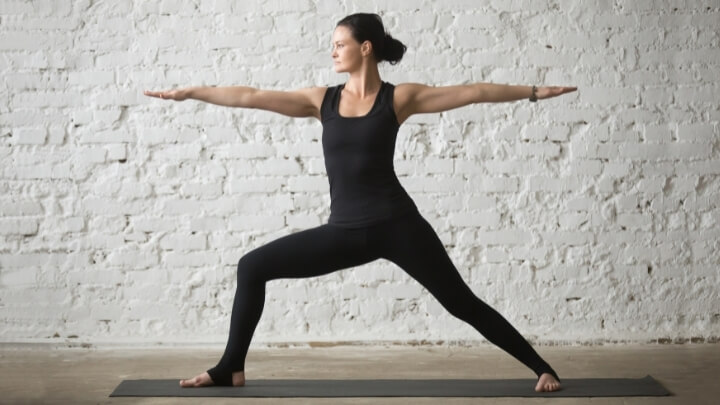
Warrior II
Position your body in a lunge with your front knee stacked over your front foot, your back leg to the side. The middle of your back foot should be in line with the heel of your front and your pelvis needs to be leveled, facing the side of the mat. Your arms should be outstretched and shoulders relaxed.
Triangle Pose
From the Warrior II pose, reach your front arm in line with the middle of your front foot. If you notice any strain, place a yoga block by the middle of your front foot, reaching for the block. Reach your back arm straight up and turn your head to look up to the top of your hand.
Runners Lunge
Bend your front knee and stack your knee right over the top of your ankle. Your back leg should be stretched out behind you, both arms placed on the inside of your front leg. If you feel too much strain, bend your back leg, bringing the knee to the mat behind you.
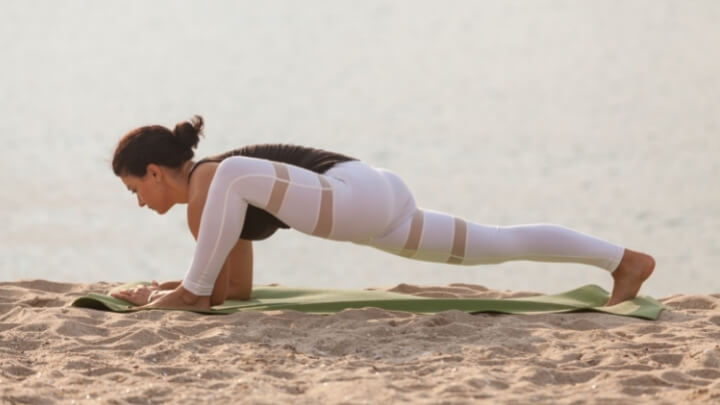
Lizard Pose
Remain in the runner’s lunge pose but allow your top knee to fall away from your body. You will feel a gentle stretch in your hips. To get a deeper stretch, bend your arms and body onto your forearms.
Pigeon
Bring your front leg in front of you at a 90 degree angle. Keeping this angle, stretch your back leg out towards the back of the mat. Make sure your hips stay level and facing the top of the mat as much as possible. Bend forward to rest on your forearms if you want a deeper stretch.
Double Pigeon
From the Pigeon pose, swing your back leg forward and stack it directly on your front foot. Both legs need to stay at a 90 degree angle and both sides of your seat need to remain firmly planted on the mat. This pose can be hard to master at first, so be patient and do your best without pushing yourself. In time it will get easier and more fluid.
Butterfly
In a sitting position, bend both knees out to the side placing the bottoms of your feet together. Stretch your legs out to the side as much as you can and for a deep stretch, fold your body forward over your legs.
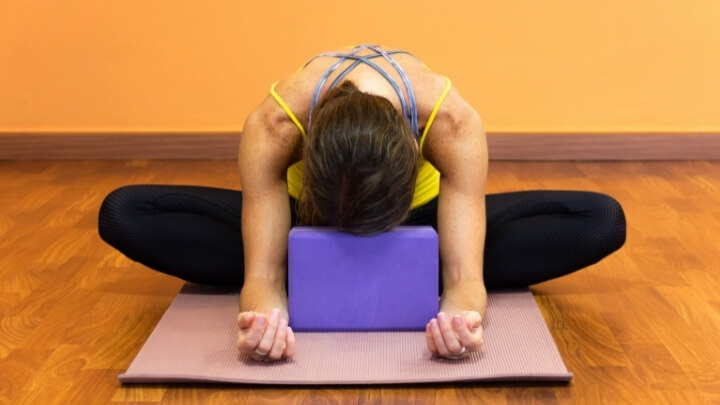
Reclined Bound Angle Pose
From the butterfly, lower your back onto the mat keeping your feet together, allowing your knees to fall out sideways. This is an easy and restorative pose that allows you to really relax. You will find you can stay in this pose for as long as you like.
Reverse Butterfly
Lying on your back, bring your legs up to the sky and grab your shins or ankles. Gently stretch your legs up in opposite directions and repeat on both sides.
Happy Baby
Still on your back, bring your knees up to your chest. Grab the outsides of your feet and stretch your hips out, lifting your feet to the sky. Often, people roll side to side in this pose for extra relaxation.
Frog Pose
This is essentially a split but on your knees. With your knees bent at 90 degree angles and with your feet flexed out, keep your knees, seat, and thighs all in a straight line. Bend forward and rest your body on your forearms.
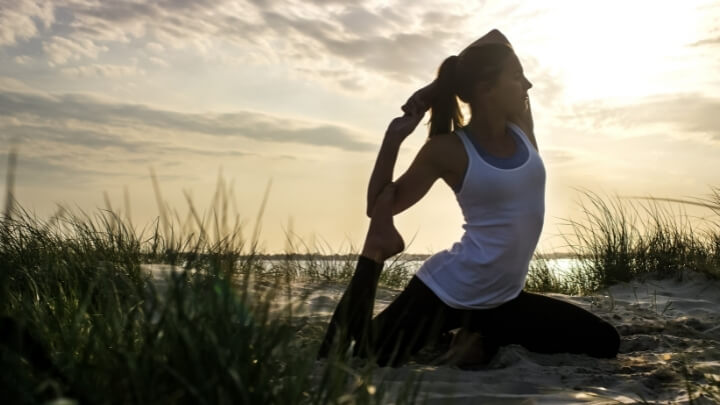
Mermaid Pose
Bend your top leg into your body and bend your back leg towards the sky. You can place your foot in the crevice of your arm. As you get more flexible, you can start to reach your front arm back to bind with the arm that is hooked onto your leg.
The Bottom Line
The practice of yoga includes the belief that we hold stress and other emotions in our hips and hamstrings. Tightness in the lower body increase risk of injury, especially for athletes. Since we may spend many hours at our desks, the quality of posture may decline.
For all of these reasons, yoga stretches are valuable to enhance flexibility and to improve physical health. Practice these 13 yoga poses to help.












